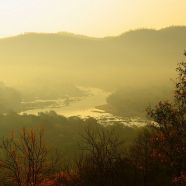
Another View of Kaveri. Photograph by Rajesh R Shenoy. http://tinyurl.com/ltv6ver
Share This
Print This
Email This
The Rivers of the Indian South: Myth, Legend, and Primordial Presence
Kaveri, Krishna, Godavari, Tungabhadra, Narmada, Ganga, Yamuna, Brahmaputra . . . in the Indian imagination, just the names of these rivers evoke poetry, myth, fable, the Gods, the sacred deities, and history—going back not just a few centuries, or even a few millenniums, but to the beginning of time when sages dreamt of time and of the mind’s machinations and of the order of the world, rta, that we desperately seek to sense and make sense of. Overwhelmed with our conscious world, we seek to give meaning to what our senses sense, and do so by telling tales and grand myths of how something came to be and passed away, for we cannot fully trust our senses.
Each river in India has tales to tell. A land settled for more than 1.5 million years by humans, or eons descending back billions of years according to Hindu speculation of the antiquity of the cosmos, created by Brahma, sustained by Vishnu, and transformed by Shiva. Seven of the many rivers that flow across Bharata or India have come to be considered sacred, although every riverine village has built temples and shrines in adoration of their grand or not so grand water world. Its men and women have sung the praises of their beloved river, which provides historical insight and imagination. Among the seven considered sacred (Ganga, Godavari, Yamuna, Sindhu, Saraswati, Kaveri, and Narmada) two flow in South India—the Kaveri and the Godavari—but here I write about the Kaveri and the Tungabhadra, for they are my beloved rivers and have influenced my own understanding of life in India.
The Tungabhadra
Although the Kaveri is the more well known of the two rivers, I will start with the Tungabhadra, which we can trace back to the times of the Ramayana, the first great Indian epic. The Tungabhadra is a confluence of two rivers—the Tunga, and the Bhadra—both of which rise in the District of Chikkamagaluru, in the mountains of the Western Ghats. They meet at the picturesque little village of Koodli, with its hoary tradition and temples dating back to the twelfth century and beyond.
The myths and legends of Hindus are infinite, more magical and powerful than what any spinner of modern “magic realism” can dream of and create, and their symbolism might take more than a lifetime to unpack and savor. It is said that Prahlada, son of Hiranyakashipu, the evil king of Puranic fame, built and worshipped at the Sangameshwara Temple at the village of Koodli where the Tunga, and the Bhadra meet. Prahalada was all that his father was not, and he is considered the greatest devotee of Lord Vishnu, describing to the world the ways of worshipping and pleasing the good Lord. Prahlada was taunted by his father, who having spent years in penance had acquired a boon that made it impossible for anyone to kill him during the day or night using any weapon known to man. Hiranyakashipu, using his boon to create havoc in the land he ruled, met his match in his son, who invoked Lord Vishnu. Lord Vishnu appeared as the half-man, half-lion Narasimha and killed Hiranyakashipu at the doorway of the palace at twilight with his claws.
Lord Narasimha is my family’s chosen deity, and we worship him in our hometown of Maddur, near the other sacred river so meaningful to my upbringing, the Kaveri. No visit to India is complete for me until I go to Maddur and stand before the deity, carved out of dark granite, in all His fierce grace and powerful presence.
My father, as a young civil engineer, was one of the members of the small army of engineers who worked on designing and constructing the Tungabhadra Dam (1949–53), and the designer of the still-standing lookout tower next to the dam. My mother then was a new wife, and very young, just a teenager. She would sit us down later and tell us tales about the days spent in a little house in Hosapete (Hospet), near where the dam was built, and how she befriended another young wife of another young engineer and learned to mind house, cook, clean, and watch the new world around her, some 200 miles away from where she had grown up.
The waters of the Tungabhadra are so sweet to drink that there is a saying in Kannada: “Ganga snaana, Tunga paana” (Bathe in the waters of the Ganga, and drink the waters of the Tunga). There are songs about the great souls who prayed, sang, and offered balm to the questing, thirsty humanity. The eighteenth-century poet Kamalesha Dasa wrote the now popular song, “Thungateeravi rajam, bhajamana Raghavendra Guru rajam,” singing the praises of the good Sri Raghavendra Swamy (1595–1671), the saint who expounded on the Dvaita (dualism) philosophy, established a monastery at Mantralayam on the banks of the Tungabhadra, and who entered alive the Brindavana (burial chamber), telling his distraught disciples and devotees that his blessings and his power would be accessible to the seeking for the next 700 years.
A British administrator, Sir Thomas Munro, was later in charge of the area, but could not figure out the ownership of the lands claimed by the monastery established by Sri Raghavendra Swamy, and decreed that it would be taken over by the British India Company. People beseeched him and told him that he could check with the saint himself, who had been then dead for more than 130 years. Sri Raghavendra Swamy is said to have appeared before the skeptical Munro as if in a mirage. Munro began talking to the saint, tears streaming down his cheeks. Raghavendra Swamy’s disciples were dumbstruck that this stranger and foreigner had been given the grace of darshana (vision of the divine) while they had, despite their long spiritual toil and deep belief, not earned that privilege. The saint, they say, appeared in a dream of the chief priest of the Mantralayam temple and told him that in ages past Munro was his playmate, when he, Raghavendra Swamy was Prahlada! Thus are the tales. . . .
I was in elementary school when my father served as the engineer-in-charge of a project in Raichur District, close to Mantralayam. He took us in his official vehicle, a Jeep, to the opposite banks of the Tungabhadra, across Mantralayam. My two brothers, two sisters, and I climbed on to the round boat (a coracle, or “Harigolu,” in Kannada), along with my father and mother, and were “rowed” across the river to the other bank. Here we experienced one of the most memorable visits to the blessed place where Sri Raghavendra Swamy still continues to draw tens of thousands of devotees, each year, and who are still fed free food that satisfies the stomach and the soul.
The pride of place in my family’s little prayer room at home now in Columbus, Georgia, all these years later is reserved for a framed image of Sri Raghavendra Swamy. Whenever there is distress and anxiety in our lives, the first words that come to my lips are prayers to the saint for succor and support. The stories of his benevolence and his blessings continue to thrill his devotees, and parents still name their sons Raghavendra, seeking the proximity we all so seek to the Gods in our harried lives.
Sringeri, where the eighth-century philosopher-saint Adi Shankaracharya propounded monism and established one of his four centers/monasteries/temples, is on the banks of the Tunga. There are many other holy places/centers along the banks of the Tunga, the Bhadra, and the Tungabhadra and it is well-nigh impossible to do justice to them all. Of particular mention is Hampi, the capital of the Vijayanagara Empire (1336–1565) that lies in magestic ruins along the Tungabhadra. If I could travel back in time and were blessed enough to interrogate Raghavendra Swamy as did Thomas Munro, I would ask the good saint what he had witnessed of the heartbreak and the devastation of the people and their grand capital city.
The Kaveri
To Kaveri, the Ganga of the South, we travel farther down south. Peninsular South India is a rocky plateau (the Deccan Plateau) bordered on the east and the west by high hills and mountain ranges—the Eastern and the Western Ghats. Much of the plateau is dry, arid, and rocky. It is said that ages ago, a rock overlooking the barren expanse dreamt of becoming a river and bringing the arid land to life. The rock performed deep tapas (disciplined meditation) and was given the boon of becoming a beautiful maiden, born to the Sage Kavera, and thus she is Kaveri. This was, of course, no ordinary rock, but Lopamudra, the handmaiden of Mohini, who was Lord Vishnu in the form of a seductress, who worked her charms to deny the demons the elixir of life. But nothing in Indian myth, fables, and the puranas are simple, linear, and singular, and one can savor the different tales of Lopamudra as she appeared in the Rig Veda, in the Mahabharata, and in the Giridhara Ramayana.
After Lopamudra was finished helping Mohini, she retired to the top of the Brahmagiri hills and became a rock. Kavera, a sage, wandering the hills, and feeling lonely, yearns for a child. Lord Brahma, pleased with Kavera’s penance, turns Lopamudra into a girl, and she thus becomes Kaveri. Upon seeing the parched land, she yearns to become a river and make her father happy. The tale meanders, like the Kaveri, bright and sparkling, cleansing and giving, bountiful and rich.
The more mundane fact is that the Kaveri river begins its path at Talakaveri in the Coorg or Kodagu District of Karnataka. It flows south through Karnataka, and the adjoining state of Tamil Nadu, and enters the Bay of Bengal at Poompuhar. Fed by multiple tributaries, each with their own legends, saints and seers, poetry and temples, Kaveri is a multifaceted river.
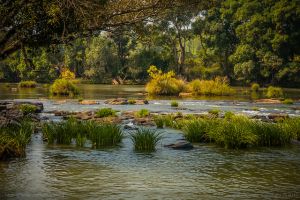
Kaveri River near Dubare Elephant Camp, Karnataka, India. Photograph by sandeepachetan.com. http://tinyurl.com/l57va7e
As a little boy, I lived in the small town of Shivanasamudra on the river Shimsha, one of the Kaveri’s tributaries. Driving down to the Gaganachukki and Bharachukki falls nearby was a thrill, as relatives came to our house during the rainy season to see the splendor of the cascading falls and to visit the great Somanathapura Chennakesava temple nearby. Shivanasamudra is about thirty miles south of Ramanagara, where I was born. It is famous for its granite outcrops, and a destination for climbers who come from all over the world to climb. Oh, yes, the Arkavathi, another tributary of the Kaveri, flows through the town of Ramanagara!
The Kaveri’s waters are now a source of battle between farmers in Karnataka and farmers in Tamil Nadu, each claiming their share and more. Tempers are frayed every year, as during the monsoon the farmers and the politicians line up, protest, burn buses, pelt stones, go to court, plead with the Central Government, and quarrel. The city of Bengaluru now depends heavily on the water drawn from Kaveri, and without the water piped from afar to the thirsty citizens of a city that has grown a hundredfold in the past thirty years, Bengaluru would not be able to sustain itself as the “Silicon Valley of India.”
In the 1960s, as a young boy, I rarely felt that India was a crowded country, though by comparative world standards, it was. In 1965, India’s population was about 500 million. Now, it is more than 1.3 billion. The waste generated by these teeming humans, the heavy industrial expansion in the same period, and the building of dams for agricultural and power generation reasons have made India’s rivers dangerously sick. The Tungabhadra and the Kaveri have both been deeply affected by this growth, but the political masters of modern India have been lax, clueless, or worse yet, complicit in encouraging the destructive and untrammeled growth. For too long they have looked the other way as corrupt industrialists, the “sand mafia,” and various other mischief-makers have made these rivers choke with sewage and industrial waste, and destroyed the beauty of large sections of the land through which they traverse.
I cannot close this essay, however, on a sour note. And I would be remiss in not mentioning one of the great music composers, also considered a saint, who lived on the banks of the Kaveri in little Thiruvayaru, close to the grand temple town of Thanjavur, in the state of Tamil Nadu. Tyagaraja wrote songs in praise of his chosen deity, Sri Rama, an avatar of Lord Vishnu. And, yes, there is a legend about Tyagaraja that will once again remind the world that we Indians are tellers of tales: in the biography of Saint Tyagaraja (Sri Tyagaraja Charita), the writer, Sundaresha Sharma, claimed that after Lord Rama ascended to heaven, one day the divine musician Narada arrived in town, and Rama asked him about life on earth. Narada bemoaned the state of affairs, telling Rama that people had forgotten the truths that He, Sri Rama, had imparted, that they did not study the Vedas anymore, and that children were spoilt rotten. Rama agreed that someone had to go down to earth to set matters right again.
Lord Shiva said that he had descended to earth recently and appeared as the Sage Adi Shankara (the one who propounded monism), and that he had done what he could. It is the turn of Hanuman, who tells Rama that he too had descended to earth and appeared in the form of Madhwacharya (the one who propounded dualism), and had set matters right establishing monasteries, teaching and interpreting the Vedas, then returned. It is the turn of Shuka next, who told Rama that he had appeared on earth as Kabir, taught the ways of bhakti, and had some success. Narada then piped up himself, and claimed that he had gone down to earth as Tulasidas, had written the Ramayana in Hindi for the ordinary people, and had kindled bhakti in the hearts of men and women.
So, who could go next to set people on the right path again? Sri Rama looked at Valmiki, the sage who wrote the Ramayana and asked him if he could go serve some time down under. Valmiki was not happy about having to leave the abode of Sri Rama but was assured he would have to spend just eighty years on earth, and was thus reincarnated as Saint Tyagaraja. When Valmiki first reached the banks of the Kaveri, his skin tingled with pleasure, and he was mesmerized at the beautiful setting of the forest full of palm trees, banana plants, and holy shrines on both sides of the river. He saw the Goddess Kaveri, resplendent in her golden form, and she blessed him and told him that she was one of the three sisters: Ganga, who protects the north of India, Godavari, who protects the middle, and she, Kaveri, protector of the south.
Tyagaraja was born in 1767 in Tiruvarur. He began composing songs when he was a teenager, and the legend goes that he composed nearly 24,000 songs, and that his students trailed after him taking notes as he composed and sang his songs, inspired by Sri Rama, on the spur of the moment, walking down the streets of Tiruvaru seeking alms from the good people of the town. Tyagaraja is now remembered, each year, at nearby Thiruvayaru, when thousands gather to sing his “Pancharatna Kritis,” basking in his love and devotion of Sri Rama, at the Tyagaraja Aradhana festival.
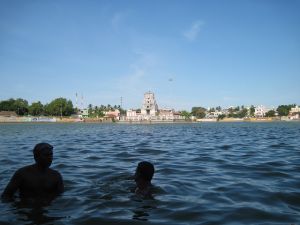
Holy dip at the temple tank of the Thyagaraja Swamy Temple at Thiruvarur. Photograph by Srinivasan G. http://tinyurl.com/nyrzwpy
Although we may live in difficult times, there are good men and women who continue to sing the great kritis of Saint Tyagaraja, and of Muthuswami Dikshitar and Shyama Shastri—two of the great triumvirate of South Indian classical music composers—and invoke their chosen deities, beseeching them to set matters right again. They go to the towns lining the Tungabhadra and the Kaveri, enter the beautiful temples, sip the waters of the rivers, and sit in silence contemplating how the earth appears before their eyes, and where their minds travel.







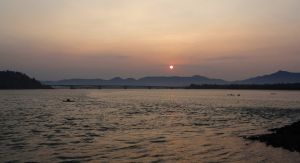
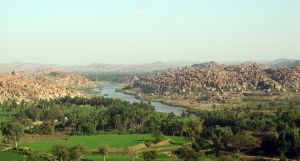
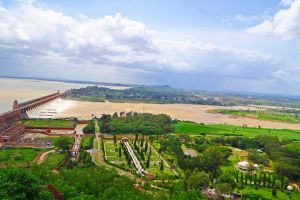
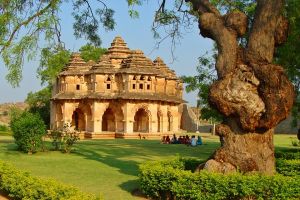
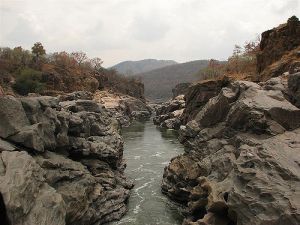
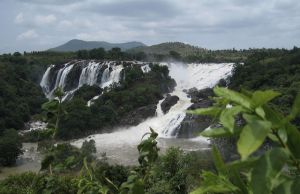
What a moving, personal description of Dr Rao’s association with the Kaveri and Tungabhadra! Ably demonstrates how the rivers are indeed mothers for us Hindus.
Thanks, Vishal… I am so glad that you found this essay good reading. Your wealth of knowledge on these matters will one day, I hope, hold in thrall the readers of South Writ Large.
Highly evocative narration! Thoroughly enjoyed reading it.
Thank you so much… What more joy can one have than find your words resonate in another?
Just mesmerising. In my childhood, communities/family and friend groups used to make trips to the banks of Tunga and Kaveri during Karthika month for a ceremonial picnic. The piece brought back all those memories. Thank you so much.
So good to read your comments, Sai… Where on the Tunga and Kaveri did your family meet? I hope you will write about it, and may be make them part of one of your new historical novels.
What a beautiful piece! Ramesh’s writing is like the stream of water running through the rivers he describes!
Thank you, good friend, for this heartwarming comments.
I really enjoyed reading this article and will forward this to my friends and relatives. Our family too has deep connections to the Tungabhadra and Kaveri rivers and so I was able to very much relate to it. Looking forward to articles on the other rivers.
Yes, each of these rivers deserves a book or many books of their own… A lot has to be done by writers, artists, and historians to bring these beautiful rivers into the lives of people around the world, Sushma.
Rajesh I read this beautiful essay 3 times because it is so beautiful. You really need to write books! I so much want to go to India. I wish you would put together a trip to visit these rivers and to hear you explain the spiritual significance of each one. Perhaps your University could offer a program or Road Scholar would organize it.
Dr. Cormier, thank you for your kind words… but you know I teach four courses a semester 🙂 but I will take your suggestion to heart, and if the Gods will, then there could be movement, like Kaveri taking birth…
Interestingly, Dr. Cormier, Road Scholar offers two of their about six India-based journeys around the Ganga/Ganges experience: https://www.roadscholar.org/find-an-adventure/21260/india-s-holy-ganges-river-rituals-history-and-the-sacred-city-of-varanasi; https://www.roadscholar.org/find-an-adventure/21644/a-spiritual-and-cultural-journey-india-s-golden-triangle-and-holy-ganges-river